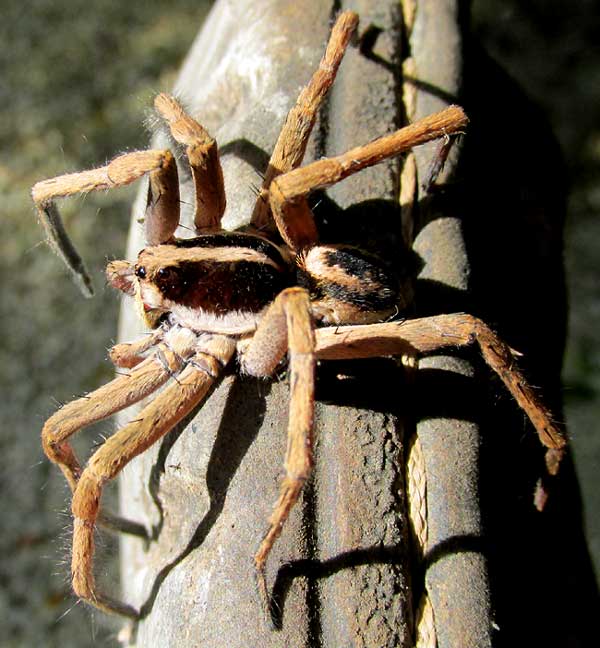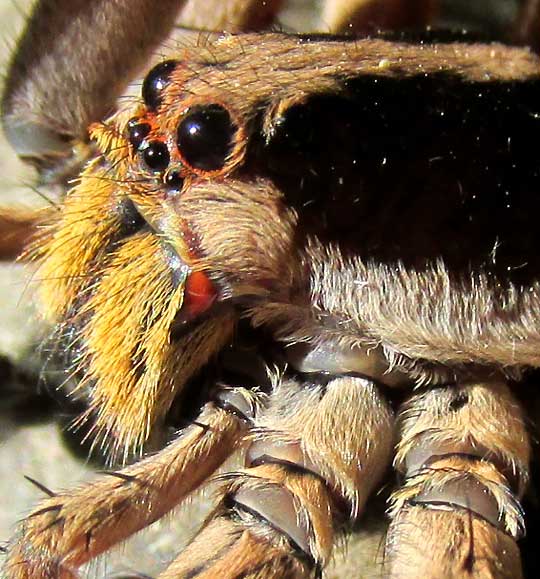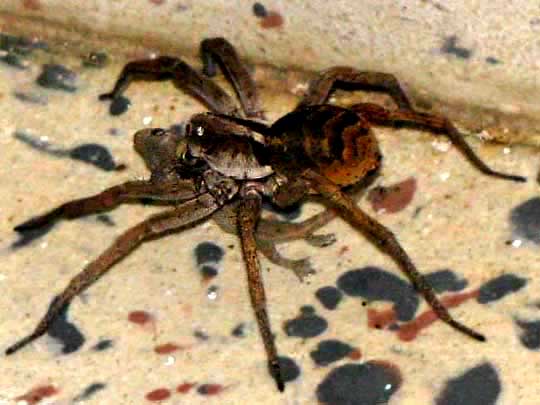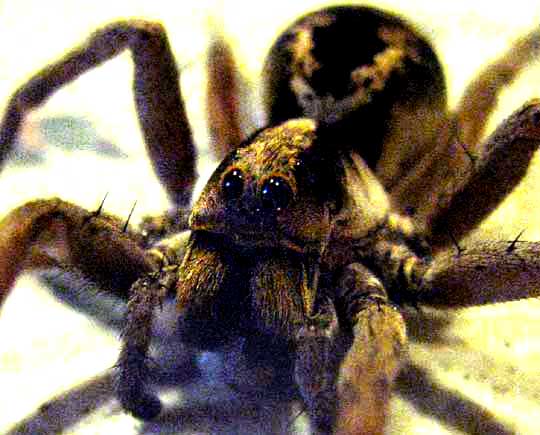Excerpts from Jim Conrad's
Naturalist Newsletter

from the November 15, 2015 Newsletter issued from Hacienda Chichen Resort beside Chichén Itzá Ruins, central Yucatán, MÉXICO
BIG WOLF SPIDER
Reaching for a sandal, something nervously bobbed to one side as my hand approached. It was the big wolf spider shown above.
I'd been looking forward to this event, for back in 2009 upon my arrival here at Hacienda Chichen I'd photographed this same species with a captured House Gecko {see entry below}. Now, at last, right here on my sandal was the very same species and this time I had plenty of light. Below, just look at the dignified creature's portrait:

The world's many wolf spider species generally hunt in the dim light of dusk, and by moonlight. In general they display two hunting strategies: either they sit quietly waiting for prey to pass by, or else they go out hunting, like tiny wolves. Though they have good eyes, they react mainly to vibrations caused by potential prey beating their wings, or walking on the ground. They eat many kinds of invertebrates, such houseflies, crickets, cockroaches, occasionally grasshoppers, and we've seen that our big ones can eat vertebrates as well, in the form of house geckos.
Identifying our present one with its red-rimmed goggles turned out to be a challenge. I'm pretty sure our sandal-sitting individual belongs to the traditional wolf-spider genus Lycosa, but of that genus about 235 species currently are recognized worldwide. The Wikipedia species list for Lycosa mentions 14 species found in Mexico. One of those species is LYCOSA MAYA, the species name suggesting its presence here in the Yucatan. Unfortunately, on the Internet I find no photographs or descriptions of that species and can't confirm that that's what we have. But that's the closest I can come to offering a name.
Lately many authors have shifted Lycosa species to the genus Hogna, but there seems to be resistance to this change, maybe because Lycosa -- the Lycos being classical Greek for "wolf" -- is such a well established and appropriate name.
from the November 15, 2009 Newsletter issued from Hacienda Chichen Resort beside Chichén Itzá Ruins; limestone bedrock; elevation ~39m (~128ft), N20.675°, W88.569°; central Yucatán state, MÉXICO
WOLF SPIDER NABS GECKO
Throughout each of the previous nights a certain House Gecko, Hemidactylus frenatus, periodically had been erupting with his somewhat loud, squeaky Krrrk krrrk krrrk krrrk! A House Gecko we met in 2005 is shown at www.backyardnature.net/yucatan/gecko-hs.htm.
One afternoon I was glad to see this particular gecko scampering across my tile floor, for I wanted to meet the maker of all that noise. I wasn't really annoyed with him, for once you get used it -- if he doesn't call exactly as you're dozing off -- it's rather nice having such a hut mate, one who minds his own business, being so engaged in his own little life. Therefore, to know this gecko better, I got down on my hands and knees for a better look.
But as I drew near something black streaked in from the left and before my brain could register what was happening a big, blackish wolf spider had taken up position atop the gecko, and apparently at that very moment was digging his fangs into the gecko's body. As the spider began rushing away dragging his prey beneath him I grabbed my camera and shot the image below:

In that picture one of the spider's side eyes is glowing because I used a flash, and spider eyes are very reflective. Back when I led nighttime wildlife- watching walks in Belize, the moment during each walk eliciting the most visitor ooooohs usually came when I'd beam a strong flashlight across the rainforest floor and it'd look as if diamonds were strewn all about, those sparkles being the eyes of large spiders.
Before the spider could get away I jumped around in front of him and shot a close-up of his head, seen below:

Even in the last picture the spider carries the gecko below, though now the prey has been shifted back and isn't to be seen from the front.